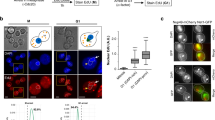Abstract
THE patterns of DNA replication in several mammalian chromosome complements have been investigated by the use of labelled DNA precursors and autoradiography1–5. Such work has established that replication of the sex chromosomes is asynchronous during the terminal stages of DNA synthesis. Several investigations have attempted to elucidate whether or not the chromosomes which terminate their replication later than all other chromosomes in a mammalian complement also start their synthesis late. In cultured cells from male and female Chinese hamsters Taylor1 observed that the late-replicating sex chromosomes duplicate only during the last half of the 6 h synthetic period. Using 5-fluorodeoxyuridine (FUdR) to synchronize cultures of diploid Chinese hamster cells, Hsu6 obtained evidence which suggested that the late-replicating Y and long arm of the X-chromosome begin DNA synthesis approximately 4.5 h after DNA synthesis has commenced in the rest of the complement. Using a comparable technique, Petersen7 independently identified a “late-starting” chromosome in cultured leucocytes from a human female, which he presumed to be the late-replicating X- chromosome. In cultured cells from bovine males, Gartler and Burt8 observed that the “late synthesizing Y- chromosome” begins replication later than the rest of the chromosomes in the complement. These observations suggest that “late-replicating chromosomes” or chromosome segments are correspondingly late in beginning DNA synthesis. Stubblefield9, however, using a modified autoradiographic technique, came to the conclusion that the “late-replicating Y” and the long arm of the X in the male Chinese hamster complement do “incorporate a significant amount of isotope during the first 15 min of synthesis”. Making use of a continuous labelling technique and a human complement with X/iso-X sex chromosome constitution, where the iso-X is known to be “late-replicating”, it has been shown10 that the iso-X chromosome begins its replication along with autosomes of comparable length and is therefore not the last chromosome in the complement to initiate replication.
This is a preview of subscription content, access via your institution
Access options
Subscribe to this journal
Receive 51 print issues and online access
$199.00 per year
only $3.90 per issue
Buy this article
- Purchase on Springer Link
- Instant access to full article PDF
Prices may be subject to local taxes which are calculated during checkout
Similar content being viewed by others
References
Taylor, J. H., J. Biophys. Biochem. Cytol., 7, 455 (1960).
German, J. L., Trans. N.Y. Acad. Sci., 24, 395 (1962).
Mukherjee, B. B., and Sinha, A. K., Canad. J. Genet. Cytol., 5, 490 (1963).
Galton, M., and Holt, S. F., Cytogenetics, 3, 97 (1964).
Chang, T., Defendi, V., and Moorhead, P. S., Canad. J. Genet. Cytol., 7, 571 (1965).
Hsu, T. C., J. Cell Biol., 23, 53 (1964).
Petersen, A. J., J. Cell Biol., 23, 651 (1964).
Gartler, S. M., and Burt, B., Cytogenetics, 3, 135 (1964).
Stubblefield, E., J. Cell Biol., 25, 137 (1965).
Mukherjee, B. B., Burkholder, G. D., Sinha, A. K., and Ghosal, S. K., Canad. J. Genet. Cytol., 8, 631 (1966).
Mukherjee, B. B., and Sinha, A. K., Canad. J. Genet. Cytol., 5, 490 (1963).
Moorhead, P. S., Nowell, P. C., Meliman, W. J., Batipps, D. N., and Hungerford, D. A., Exp. Cell Res., 20, 613 (1960).
Sasaki, M. S., and Makino, S., J. Heredity, 53, 157 (1962).
Mukherjee, B. B., and Sinha, A. K., J. Med. Genet., 2, 157 (1965).
Lima-de-Faria, A., Reitalu, J., and Bergman, S., Hereditas, 47, 695 (1961).
Mueller, G. C., and Le Mahieu, M., Biochim. Biophys. Acta, 144, 100 (1966).
Bond, V. P., Cronkite, E. P., Fliedner, T. M., and Schork, P., Science, 128, 202 (1958).
Rubini, J. R., Keller, S., Eisentraut, A., and Cronkite, E. P., in Tritium in the Physical and Biological Sciences, II, 247 (International Atomic Energy Agency, Vienna, 1962).
Author information
Authors and Affiliations
Rights and permissions
About this article
Cite this article
MUKHERJEE, B., SINHA, A., MANN, K. et al. Replicative Behaviour of Bovine X-chromosomes during Early DNA Synthesis. Nature 214, 710–712 (1967). https://doi.org/10.1038/214710a0
Issue Date:
DOI: https://doi.org/10.1038/214710a0
This article is cited by
-
Replication pattern of the X and Y chromosomes in partially synchronized human lymphocyte cultures
Chromosoma (1972)
-
Early DNA Replication Patterns of the Normal Sex Chromosomes and a Presumptive X-autosome Translocation in Cattle (Bos taurus L.)
Nature (1971)
-
Further Evidence for the Simultaneous Initiation of DNA Replication in both X Chromosomes of Bovine Female
Nature (1968)
-
Chromosome studies in the superfamily Bovoidea
Chromosoma (1968)
-
Asynchrony of DNA replication and mitotic spiralization along heterochromatic portions of Chinese hamster chromosomes
Chromosoma (1968)
Comments
By submitting a comment you agree to abide by our Terms and Community Guidelines. If you find something abusive or that does not comply with our terms or guidelines please flag it as inappropriate.



